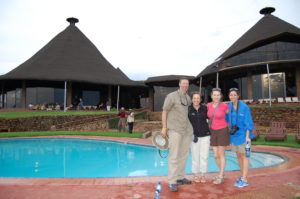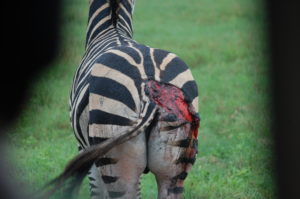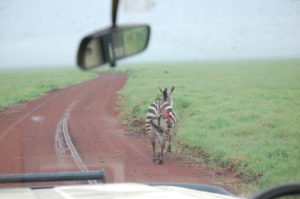Part 1: Poa Kichizi Com Ndezi
Part 2: The Journey to the Top of the World
Part 3: Rise Up
I’ve been back from our Survivor Summit climb up Mount Kilimanjaro for exactly one month now. I’ve thought about describing our return down the mountain (harder than going up, if you can believe that and another adventure in itself) and the safari (SO GOOD!), but I haven’t been able to sit down and actually write anything. I know that several of my Survivor Summit teammates are having a similarly hard time articulating parts of the two weeks. When people ask how the climb was, many times all we can muster is, “It was awesome.” “Book of Mormon” was awesome; Survivor Summit deserves to be described as much, much more than that. But we, or at least I, couldn’t find the words.
It felt like I’d blown my writing wad (!) after my summit post. It was exhausting and I had nothing left, even though I hadn’t finished documenting what we did. The biggest part of the problem was that, like a snapshot, even if it’s the perfect picture, I couldn’t capture the 360-degrees of the experience with linear writing or talking for that matter. Does that make sense? No matter how I described the adventure, I couldn’t get across the enormity or the beauty or the strength or the spirituality of what I felt and lived through with these 15 people who have become part of my heart and soul. So I wrote nothing. I’ve shared photos with friends and on Facebook, but still couldn’t motivate myself to write us down the mountain in this blog.
Then, my very good friend, Andrea, invited me to share the story at an event at Neiman Marcus in Orlando, where she is on the executive management team. I’d be part of a series of speakers who are Women Who Do Cool Things… or something like that. The serendipity of this invitation on several levels was incredible. I said yes immediately.
Now, I would be forced to reshape this glorious ameoba-shaped experience into a linear experience with a story line and photos that come up on the screen one by one. It was exactly what I needed to mountaineer over what was becoming a big writer’s block. I told the group about how the 6 days of hiking were physically way tougher than we’d expected.. How 16 near-strangers worked as a team to get all of us up to the true summit of Kili and became best friends and a well-oiled support system in the process… How powerful and soul-changing the accomplishment was both for us and as a statement about survivorship. I talked us up the mountain, around the summit, back down, and to the safari in Ngorongoro Crater. Writer’s block summited, and here I am again, with the rest of the story.

If I’ve shown you this before, it’s ok. It’s incredible enough to see again. Summit Day. All 16 of us
We stayed on the summit for 45 minutes to an hour, I think, until Chris Warner, one of our two U.S. guides, noticed that some of us were getting a little loopier than what would be optimal to safely descend. By now, we’d been at 19,000 feet or above for 6 or 7 hours. (Oh, did I mention that on about day 4, when I asked Chris if he’d brought kids up mountains, he said no, because of brain cell death…. Brain cell death? No one EVER said anything about brain cell death. Just as well, I suppose.) Then, my climbing partner, Rob, looked at me with gigantic, dilated eyes and said, “I’ve got to go down. Now.” I asked for time for one more photo, but he was already going, so I went, too (I’m a good partner!).
Going down was physically way harder than climbing up. We took 6 days to go up 25+ miles… We took 2 days, including our summit day to go down. After scrambling down over treacherous boulders and on what looked like they may or may not be trails, there were huge sections of volcanic gravel on what felt like a 10-percent grade. Trying to slow yourself down was impossible, so the skiers among us did a modified Tele-hike-slide straight down. Think lunges downhill on squirrelly surfaces. THAT was actually fun, fun, fun (until it wasn’t) and fast. Then we took a break, and when I stood up again and my quad muscles said, “We don’t think so” and went into major spasm We passed other hikers from other groups on the descent, as there are only a couple of trails going down. Several of them didn’t look so good. Porters were carrying a couple of hikers down, and we saw at least two lying in the middle of the path (They were just trying to recover so they could keep going.. We didn’t leave them for the vultures). It made us glad for about the thousandth time, that our guides, both American and African, took such good care of us. Slow going up, lots of hydration, a well-crafted conservative strategy, and we all descended pretty well. There were some horrible blisters and we all walked around like we were 80 years old for a couple days after, but it was a successful descent.
You may remember that the day of the night we left for the summit, we’d hiked 4 or 5 hours to high camp at 15,000 feet, rested til 11 pm then hiked up to the Summit, which we reached around 8 am, maybe… Then, we hiked back down to high camp, which was about 4 more hours, and ate lunch. Then, we hiked another 6 hours down to about 12,000 feet if I remember correctly. My math may be off, but it was a lot. The euphoria of success at the summit had long worn off. I just wanted to take my dang boots off.
The next day, we hiked another 12 miles down to a hot meal (and more rain), and got our certificates for climbing to Uhuru Peak, and it was off to the next adventure, the safari, which was fantastic because of all the animals and because we got to ride in vehicles without our hiking boots on. 🙂 We spent a few hours in Manyara Park, AKA Baboonville. I’ve never seen so many baboons. It looked like a (fill in the blank… fraternity party, sporting event, newsroom…. hee hee). We’d been warned about the baboons getting in your vehicle to eat your food. I kind of wanted to see that (in someone else’s vehicle) and kind of didn’t.

Sopa Hotel in Ngorongoro Crater. Hot showers. Hot water bottles in the bed. A BED. A buffet. Heaven.
I remember studying Ngorongoro Crater in elementary school and was excited to actually be in it. Our guide said most of the animals that are in there can’t get out, so it’s like a big real-life Lion Country Safari. (It drives me nuts when people go to, say, Bavaria, and tell you it looks just like Disney… and I just did the same thing.) You’d look out and in one direction, you’d see four or five different kinds of animals ignoring each other. And it’s good to be a lion in the Crater. It’s like a smorgasbord of food that can’t escape. The cats are fat. Here are some of my favorite photos from the safari:

He’d been attacked by a lion, as you can see. Someone said he had a really bad day. I said he had a really GOOD day, as it wasn’t his LAST day

This is my third safari, and my goal was to see a rhino, the only one of the Big Five I haven’t seen. We saw a few. So. Cool.

As we were leaving the park, we saw this mom and her cubs. our guide says they’re about two weeks old. Their eyes are still blue.
It was hard to say good-bye to my Survivor Summit teammates. It’s always hard to end a good adventure, and this is the best one I’ve ever had. I didn’t want the magic to end. But it really wasn’t “good-bye;” it couldn’t be. We already have plans to get together in October (in Austin, of course), and I’ve already seen three of the gang in the last month. I’d bet that most of us have made some kind of connection with a teammate or five every day since February 20 or 21 when we scattered. I know I don’t want to let any of it fade.
Still to come: Marc Middleton shot a documentary of the climb and is working on it right now. He showed me some of the video and interviews and read me some of the copy. It’s riveting. You won’t want to miss it. And some of us already talking about the next climbing adventure. I’m going up Mt. Fuji with my dad in July (this is a whole different story). And who’s up for Cotopaxi in February? Livestrong.









Although I completely understand the need to process this whole adventure, I was so happy to read this. I can’t wait for Mark’s documentary.